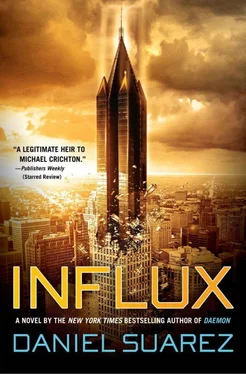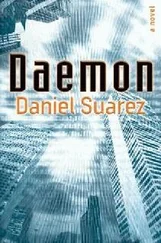In loving memory of Alan Haisser, a brilliant engineer who encouraged my youthful wonder—but still insisted I learn the math.
The future is already here—it’s just not very evenly distributed.
—WILLIAM GIBSON
“I’m gonna hunt you downlike a rabid dog, Sloan.” Albert Marrano clenched his teeth on an e-cigarette as he concentrated on a tiny screen.
“Don’t joke. My sister’s pug just went rabid.”
“You’re kidding.” Marrano thumbed the controls of his handheld game console.
“Raccoon bite. They had to put Mr. Chips down. Her kids are still in therapy.” Mashing buttons on his own wireless console, Sloan Johnson sat in the nearby passenger seat. Then he let out a deep “Heh, heh.”
Marrano cast a look at him. Johnson had that Cheshire cat grin on his face again. “Shit…” Marrano tried to rotate his player around, but Johnson’s avatar was already behind him.
Double-tap. The screen faded.
“You really do suck at this, Al.”
“Goddamnit!” Marrano tossed the device onto the car’s stitched leather dashboard and pounded the steering wheel. “You have got to be kidding me. Worse than playing my goddamn nephew.”
“That’s two thousand bucks you owe me.”
“Best out of five?”
Johnson powered down his device. “It’s a lousy two K. What are you complaining about?”
Headlights swept across them as another car turned into the nearly empty parking lot of a gritty industrial building.
“Here we go.” Marrano pocketed his e-cigarette.
“’Bout fucking time.”
They exited their parked Aston Martin One-77 as an older Mercedes pulled toward them.
“Jesus, look at this thing.”
“They go forever, though.”
“You ever get stuck behind one of these on the highway? Like breathing coal dust.” He motioned for the driver to pull up to them.
The Mercedes parked, and a distinguished, if disheveled, elderly South Asian man with spectacles and a full head of unconvincing jet-black hair got out. Slowly. He buttoned his greatcoat against the cold.
Marrano and Johnson approached, removing their leather gloves and extending hands. Marrano smiled. “Doctor Kulkarni. Albert Marrano. Thanks for coming out so late.”
“Yes.” They shook hands. “I don’t usually drive at night. But your CEO said this couldn’t wait.”
“That she did.” Marrano turned. “This is my colleague, Sloan Johnson. He manages the portfolio for Shearson-Bayers.”
They shook hands as well. “Pleased to meet you.”
“Likewise.”
Marrano pulled his lambskin glove back on. “So you’re our physicist. Princeton, right?”
Kulkarni nodded. “Yes, but I live close by in Holmdel. No one would tell me what this is about.”
Marrano grimaced. “Not over the phone, no. Legal says they already have you under contract, so I’m supposed to remind you about your nondisclosure agreement and noncompete clause.”
The elderly Indian nodded impatiently. “Fine, fine. Now what is this ‘physics emergency’ of yours?”
Marrano waved his arm to encompass the drab, windowless building before them. “Tech start-up. Run by a couple particle physicists developing chiral superconductors. The investment predates me, but these guys claim they’ve made some big breakthrough. I’ll be damned if I can understand a thing they’re saying.”
Johnson edged in. “We need you to evaluate their scientific claims. Tell us if they’re on the level.”
Kulkarni nodded. “Is there a business plan or lab report I can review?”
Both men exchanged looks. Marrano answered, “We can’t part with printed material at this point, Professor. You’ll have to review this firsthand.”
“Then I’ll need to speak with the founders. Tour the facility.” Kulkarni eyed the darkened building.
“Oh, they’re in there.”
“This late?”
“Yeah. Blowing through thirty thousand dollars an hour in off-peak electricity.”
An electrical hum became all the more noticeable from behind a nearby fenced transformer yard as he mentioned it.
“We were told not to leave this place or talk to anyone until we got confirmation from an expert. Apparently whatever these guys sent the eggheads in New York turned some heads. Frankly, I have my doubts.”
Johnson added, “We’re supposed to have you confirm that it’s for real.”
Kulkarni adjusted his spectacles to keep them from fogging. “That what’s for real?”
Marrano shrugged. “Like I said: I don’t even understand it. Something about ‘ionic lattices.’ Follow me.” He brought them toward a windowless steel door in a nearby brick wall, then tapped in a code at a keypad. The door beeped and unlocked. He ushered them inside.
The group walked down a narrow drywall corridor with a lofty ceiling. Ahead they could hear the echo of laughter in a cavernous space. A deep hum permeated the corridor, along with the smell of ozone. There was a loud bang somewhere, followed again by hoots of laughter and breaking glass.
“Is it safe?”
“Not sure, Professor.” Marrano walked onward.
Moments later, the trio came out into a large, darkened workspace, with a high, exposed girder ceiling. Work lights glowed from the center of the room, casting long shadows on the walls. Big as it was, the room was still cluttered—its edges lined with overflowing shelving units and banks of heavy-duty electrical capacitors. LED lights glowed on the equipment, digital readouts fluctuating widely. Rows of rubber-topped lab tables stood in their path, every inch piled high with circuit boards, oscillators, 3D printers, and heaps of electrical components. There were also origami geodesic models in all sizes. The place looked more like the attic of an eccentric hoarder than a laboratory.
Marrano halted them as he noticed shattered glass, broken furniture, and unknown liquids scattered across the concrete floor. A glance up also revealed dents and holes pounded into the wall behind them. They were downrange of something.
A burst of light in the center of the room drew their attention to a towering circular assembly. It was roughly ten feet in diameter and rose up to the thirty-foot-high ceiling. Thick electrical cables snaked through it, woven in and out of metal scaffolding and what appeared to be color-coded coolant piping. There were OSHA warning signs for high voltages, liquid gases, and corrosive chemicals. The assembly was clearly the focus of much organized activity, while the rest of the room had been allowed to go feral.
At the heart of the massive assembly was a concave stone or ceramic pedestal several feet in diameter—shaped like a lens—above which was an array of metal rods, their tips aimed at the center of an imaginary sphere. The open space that the sphere encompassed was roughly six feet in diameter. Other sensor arrays and test rigs were distributed around the platform as well—tubes, pipes, wires, cameras, and more inscrutable devices, all aimed at the empty space at the heart of the machine.
Next to it stood the silhouettes of four men in coveralls with an assortment of hard hats, lab goggles, and, on one, a black paintball mask. They were crowded around a flat-panel computer monitor perched on a cart. Cables ran from it back into the scaffolding tower. As they read the contents of the screen, one of the researchers suddenly shouted, “Off-axis acceleration zero-point-nine-three-nine! Hell, yeah, baby!”
Читать дальше













